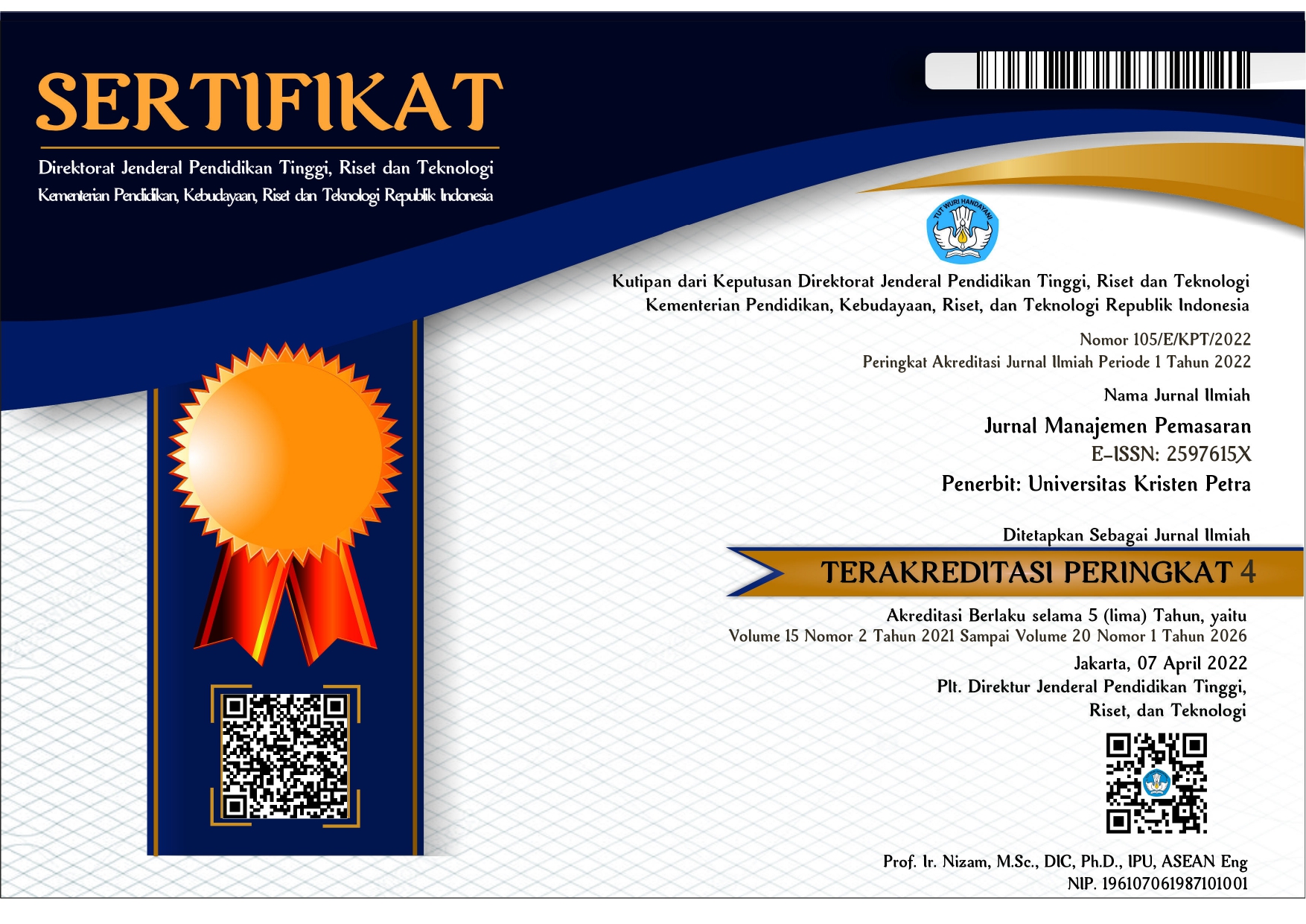ANALISA PENGARUH BRAND REJUVENATIONTERHADAP PEMBENTUKAN PURCHASE INTENTION DENGAN BRAND IMAGESEBAGAI VARIABEL INTERVENING PADA TEPUNG PREMIKS CHESA BOX PT. ISM BOGASARI FLOUR MILLS
 :
:
https://doi.org/10.9744/pemasaran.9.2.54-63
Keywords:
Brand rejuvenation, product innovation, repositioning, brand image, purchase intentionAbstract
Chesa Box Premix Flour is a product of consumer goods produced by PT. ISM Bogasari Flour Mills. In 2002, Chesa Box Premix Flour has been produced and sold in bulk, but in 2004 had to be discontinued because of the internal reason on the company. After more than ten years, in 2014 Chesa Box Premix Flour re-introduced to the market using the brand rejuvenation strategy. This research aims to analyze the relationship between brand rejuvenation, product innovation, and repositioning towards the formation of purchase intention on Chesa Box Premix Flour by using its brand image as an intervening variable. This causal research using questionnaires as a method and will be distributed to 110 respondents which is a sample of this research. The results showed that all of the variables involved in this study each have a significant impact as evidenced by the method of hypothesis testing t-test or reject the rejection of H0 if [T-stats] > T table that is equal to 1.96.References
Babu, V. (2006).Issues in Brand Rejuvenation Strategies. Retrieved from http://www.expectad. com/white_paper/Brand_Rejuvenation_Expect_Advertising_Inc.pdf.
Beneke, Justin. (2010). Consumer perceptions of private label brands within the retail grocery sector of South Africa. African Journal of Business Management. 4(2), pp. 203-220.
Berenson, C., Iris Mohr-Jackson. (1994). Product Rejuvenation: A Less Risky Alternative to Product Innovation. Business Horizon. November – December 1994, p. 51-57.
BPPK, Keuangan. (2014). [available at: http://www. bppk.kemenkeu.go.id/]
Chaniotakis et al., (2010).Consumers’ intentions of buying own-label premium food products. Journal of Product and Brand Management, pp. 327-344.
Ghozali, I. (2011). Structural Equation Modeling Metode Alternatif dengan Partial Least Square PLS, Edisi 3: Semarang. Badan Penerbit UNDIP.
Gogoi, Bidyut Jyoti (2013). Study of Antecedents of Purchase Intention and Its Effect on Brand Loyalty of Private Label Brand of Appeal. International Journal of Sales and Marketing. 3(2), pp. 73-86.
Gopalakrishnan, S., J. Damanpour (1997).A Review of Innovation Research in Economics, Sociology, and Technology Management. Omega, International Journal Science. 25(I), pp. 15-28.
Groucutt, Jonathan, (2006). The life, death and resuscitation of brands. Handbook of Business Strategy, 7(1), pp. 101–106.
Hanaysha, Jalal, Haim H., Noor Hasmini Abdul-Ghani (2014). Direct and Indirect Effects of Product Innovation and Product Quality on Brand Image: Empirical Evidence from Automotive Industry. International Journal of Scientific and Research Publications, 4(11).
Jaafar, Siti N., Pan Ein Lalp, Mohaini, M. (2012). Consumers’ Perception, Attitude, and Purchase Intention towards Private Label Food Products in Malaysia. Asian Journal of Business and Management Science, 2(8), pp. 73-90.
Kanagal, Nagasimha G. (2015). Innovation and Product Innovation in Marketing Strategy. Journal of Management and Marketing Research, 18.
Kapferer, J. N. (2008). The New Strategic Brand Management: Creating and Sustaining Brand Equity Long Term. London and Philadelphia. Kogan Page.
Keller, Kevin Lane, (2013). Strategic Brand Management: Building, Measuring, and Managing Brand Equity, Fourth Edition. Pearson Education Limited, USA.
Khan, N., Syed Hamed R. R, Hong Yong Hoe, Tan Booi C. (2015). Causal Relationship among Dimention of Consumer-Based Brand Equity and Purchase Intention. International Journal of Business and Management,10(1), pp. 172-181.
Kolbl, Ž., Konečnik Ruzzier, M., Kolar, T. (2015). Brand Revitalization: Don’t Let Your Brand Turn into Sleepyheads. Central European Business Review, 4(2), pp. 5-11.
Kotler, Philip. (2003). Marketing Management. Eleventh Edition. New Jersey: Pearson Education International.
Kotler, Philip. (2007). Prinsip-Prinsip Pemasaran. Jakarta: Erlangga
Liljander, Veronica, Pia Polsa, Allard Van R.(2009). Modelling consumer responses to an apparel store brand: Store image as a risk reducer. Journal of Retailing and Consumer Services, 16(4), pp. 281-290.
Liu, C. M, Lin, K.W., Huang, C.J, (2014). Effects of product development on operating performance in textile industry. Anthropologist, 17(1), pp. 157-163.
Schiffman, Leon C., and Leslie Lazar Kanuk. (2007). Consumer Behaviour, 9th edition. New Jersey: Pearson Prentice Hall.
Schiffman, Lazar Kanuk, in collaboration with Joseph Wisenblit. (2010). Consumer Behaviour. Tenth Edition. Global Edition. New Jersey: Patience Hall International, Inc.
Shah, Syed, S. H., Jabran Aziz, Ahsan Raza Jaffari, Sidra Waris, Wasiq Ejaz, Maira Fatimah, dan Syed Kamran Sherazi. (2012). The Impact of Brands on Consumer Purchase Intention. Asian Journal of Business Management, 4(2), pp. 105-110.
Shiau, Horng-Cherng, (2014).The Impact of Product Innovation on Behavior Intention: The Measurement of the Mediating Effect of the Brand Image of Japanese Anime Dolls. Anthropologist, 17(3), pp. 777-788.
Sugiyono. (2010). Metode Penelitian Bisnis.Bandung: Alfabeta.
Suroso, Bayu, H., Sri Setyo Iriani, (2014). Pengaruh Inovasi Produk dan Harga terhadap Minat Beli Mie Sedaap Cup.Jurnal Ilmu Manajemen, Vol. 2(4), p. 1174-1185.
Thomas, Sunil. Kohli, Chiranjeev. (2009). A Brand is Forever! A Framework for Revitalizing Declining and Dead Brands. Business Horizons, 52, pp. 377-386.
Uliana, Dina, (2012). Pengaruh Inovasi Produk terhadap Purchase Intention: Studi pada Starbucks VIA. Jakarta: Universitas Indonesia.
Wang, Ya-Hui, Cing-Fen Tsai (2014).The Relationship between Brand Image and Purchase Intention: Evidence from Award Winning Mutual Funds. The International Journal of Business and Finance Research, 8(2).
Zeithaml, Valarie A. (1988). Consumer Perception of Price, Quality, and Value: A Means End Model and Synthesis of Evidence. Journal of Marketing, 52, pp. 2-22.















